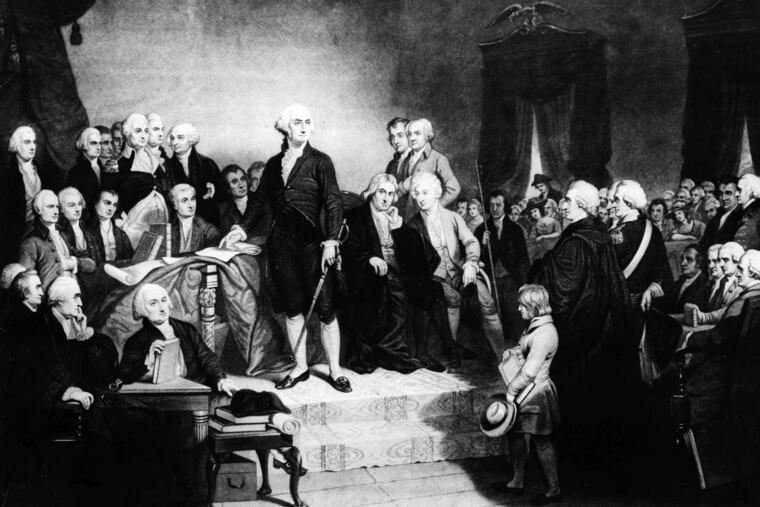Why George Washington has two birthdays — and neither falls on Presidents’ Day
Depending on which calendar you are using, the Gregorian or Julian, Washington was born on Feb. 11, 1731, or Feb. 22, 1732. They were the same day.

On Feb. 11, 1750, a young land surveyor named George Washington completed his 19th trip around the sun. It is unclear where he spent this birthday, but since it wasn’t surveying season, it is probable he spent it at Ferry Farm with his mother and younger siblings, or at his older half brother Lawrence’s place, Mount Vernon, where he much preferred to hang out.
Exactly a year later — after a busy season of surveying cut short by a trip to Barbados and a case of smallpox — he turned 20.
The date was Feb. 22, 1752.
Yes, there were exactly 365 days between Feb. 11, 1750, and Feb. 22, 1752.
In the six months after that 20th birthday, Lawrence died and Washington applied for a spot on the colonial militia. He went to bed on Wednesday, Sept. 2, and woke up on Thursday, Sept. 14. There's no record of what he did between Sept. 3 and Sept. 13, because in 1752, those days did not exist.
Monday marks the federal holiday officially called Washington's Birthday, known mostly as Presidents' Day, a day designated, depending on which state you live in, to honor the first president, the first and third presidents, the first and 16th presidents, or all presidents.
» READ MORE: What’s open and closed in Philly on Presidents’ Day
It's kind of a squishy holiday, which is fitting, considering that in Washington's own lifetime he and millions of other people chose to change their birthdays when the British Empire and its colonies switched from the Julian calendar, in use since the days of Julius Caesar, to the Gregorian calendar.
(Warning: The following paragraphs contain a little math.)
The Julian calendar calculated a year as 365 days and six hours — meaning most calendar years had 365 days, with one full day being added every four years — a leap day — to keep the calendar in line with Earth's revolutions around the sun.
But as time went on, scientists realized that 365 days and six hours was not the correct calculation. One revolution of Earth around the sun actually takes 365 days, 5 hours, 48 minutes and 45.25 seconds.
It doesn't sound like much of a difference, but over the centuries, that 11 minutes and change added up to more than a week of days that happened on the calendar — a human construct — but not in our planet's seasons or movements — the physical phenomena the human construct was supposed to measure.
The Gregorian calendar, the one we have now, was designed to fix this. In the Gregorian calendar, the rules of adding a leap day are a little more complicated than how we usually think of it. Leap days are added every four years, except in a century year that cannot be divided by 400. So the years 1800 and 1900 did not have leap days, but the year 2000, the only century year most of us will ever experience, did, because 2000 divided by 400 is 5.
(This concludes the math portion of this article.)
Pope Gregory XIII introduced his new calendar in 1582, and most Catholic countries followed suit. But Anglican England and its colonies didn't make the switch for another 170 years, which meant adding 11 days to the calendar overnight.
And you thought daylight saving time was bad.
There was one other change, too. New Year's Day, the day the calendar year changed, used to happen in late March, as it was more associated with spring. (Readers familiar with Norouz: Yes!) But when England and its colonies switched, they also moved New Year's Day to Jan. 1 (except for Scotland, which was already using Jan. 1 for the new year). The calendar year 1751 was only about nine months long, going from March 25 to Dec. 31, meaning anyone born between Jan. 1 and March 25 had to start using a different birthday and a different birth year, or continue using an inaccurate birthday and birth year — even though the number of days they had spent on this spinning rock was unchanged.
That is why, depending on which calendar you are using, Washington was born on both Feb. 11, 1731, and Feb. 22, 1732. They were the same day.
It is all pretty head-spinning, and the easiest way to deal with it back then was to calculate what your Gregorian birth date would have been and adopt that. That's what Washington and Benjamin Franklin — the tech geeks of their day — did, though most people stuck with their Julian birthdays and griped about having 11 days "stolen" from them.
Tobias Lear alluded to this idea in 1790, when replying to a letter from someone who wished to know the president’s birthday. Lear was in his 20s at the time, born a decade after the calendar change, but as Washington’s secretary he would have been familiar with the “old style” Julian calendar and the “new style” Gregorian. He wrote: “It will be sufficient to observe that it is on the 11th of February Old Style; but the Almanack-makers have generally set it down opposite to the 11th day [11 days later] of the present Style … but I could never consider it any otherwise than as stealing so many days from his valuable life.”
This may sound goofy and old-timey, like bleeding or quill pens, but the modern American government made its own awkward calendar change as recently as 1971, with the Uniform Monday Holiday Act. That officially changed the holiday marking Washington's birthday to the third Monday in February. Depending on the year, the holiday falls anywhere between Feb. 15 and Feb. 21.
It never falls on Washington’s actual birthday, regardless of which calendar you use.